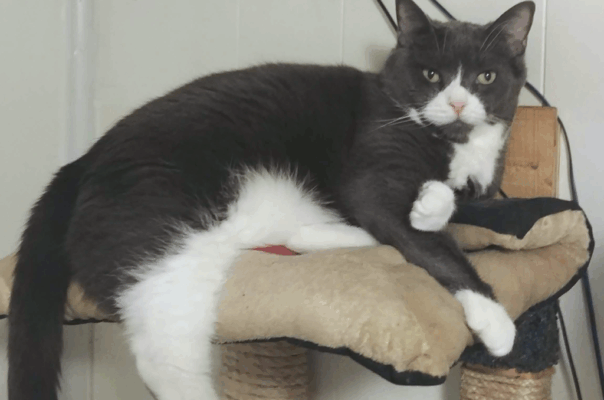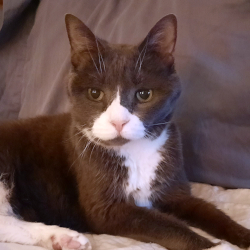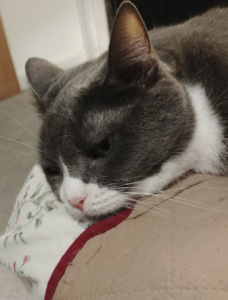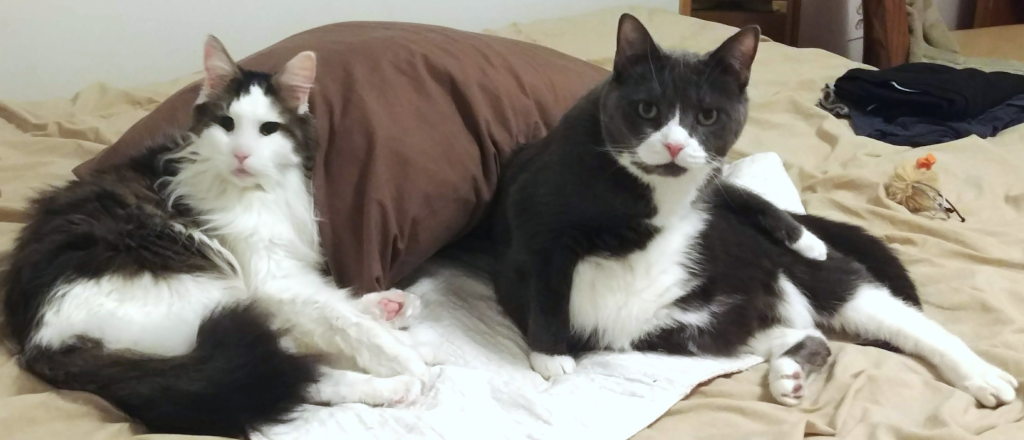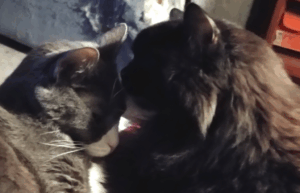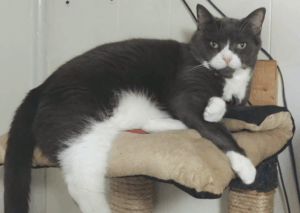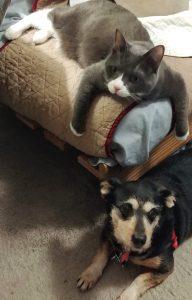With an extremely heavy heart, we must share that Belle crossed the rainbow bridge on May 28, 2024, joining her brother Paws. We were blessed with Belle’s companionship for over eight years after her rescue, and she lived to the remarkable age of almost 21. She was an exceptionally loving and perfect companion.
The loss of Belle has left an immense void in our lives. Both Belle and Paws brought so much love when they entered our home, and their absence now weighs heavily on our hearts. As I write these words, I find myself wiping away tears, unable to fully express how deeply they will be missed.
Adjusting To A New Home
When Belle was rescued, she was in relatively good health but overweight, as was her brother Paws. They had been accustomed to free feeding from a constantly filled bowl of dry food in their previous home, which explained their weight issues. In our home, we maintain scheduled feeding times rather than free feeding, and both cats adapted quickly to this new regimen, immediately beginning to lose weight. Transitioning them to wet food along with managed feeding times also improved their activity levels, which had initially been quite low.
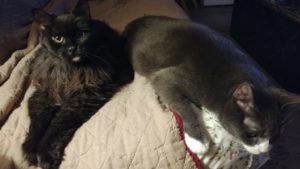
Interestingly, Belle and Paws exhibited a peculiar behavior—they never left the floor. It became evident that in their previous home, they likely weren’t permitted on furniture or elevated surfaces. Their excess weight also limited their ability to jump, though they didn’t even attempt it. Despite having ceiling-high cat trees in every room, they initially avoided these structures or only used the lowest levels that required no jumping.
 After several months of weight loss and increased activity with us, Belle began jumping onto furniture and climbing higher in the cat trees. Her happiness was apparent whenever she reached new heights, always seeking our attention to acknowledge her accomplishment. Gradually, Belle established herself as the ruler of the cat trees, frequently perching on the top level or in the highest tower, proudly displaying her achievement. Watching her joy was both heartwarming and delightful.
After several months of weight loss and increased activity with us, Belle began jumping onto furniture and climbing higher in the cat trees. Her happiness was apparent whenever she reached new heights, always seeking our attention to acknowledge her accomplishment. Gradually, Belle established herself as the ruler of the cat trees, frequently perching on the top level or in the highest tower, proudly displaying her achievement. Watching her joy was both heartwarming and delightful.
Belle’s transformation was remarkable—from an overweight, sedentary cat to a slimmer, highly active companion. She enthusiastically interacted with all our pets, befriending every cat and dog in our home. Her affectionate nature showed as she would curl up next to any animal, sometimes simply keeping them company and other times sleeping alongside them.
Belle’s Constipation
Constipation was a recurring challenge for Belle. She would occasionally go 2-3 days without using the litter box for bowel movements, which noticeably affected her behavior—she would become increasingly lethargic and withdraw, preferring to be left alone. The first occurrence was particularly concerning and prompted immediate veterinary attention.
After a thorough examination including an ultrasound, the veterinarian diagnosed Belle with constipation. She received treatment with a suppository and lactulose to provide relief. The response was remarkable—Belle used the litter box that same night and transformed back to her normal, vibrant self as if nothing had happened.
As this became a recognizable pattern with Belle, we learned to identify the early signs and would administer lactulose when needed, which consistently helped her feel better once she visited the litter box. Eventually, we incorporated Miralax into her daily routine as a preventative measure.
We also introduced Fortiflora, a veterinary probiotic supplement specifically designed for cats. Fortiflora contains specialized strains of beneficial bacteria that help restore intestinal microflora balance, which is crucial for proper digestion and stool consistency in cats. The supplement works by introducing healthy bacteria into the gut, aiding in breaking down food more efficiently and promoting regular bowel movements. It also contains essential nutrients that support overall digestive health and can help strengthen the immune system.
For many cats with chronic constipation or digestive sensitivities, Fortiflora can reduce inflammation in the digestive tract, improve nutrient absorption, and help maintain proper gut motility. It’s particularly beneficial for older cats like Belle, whose digestive systems naturally become less efficient with age.
However, Belle was occasionally finicky about her food when Fortiflora was mixed in, sometimes refusing to eat altogether. Due to this challenge, we used it intermittently rather than daily, primarily when we noticed early signs of digestive discomfort.
Belle as Skittles’ Support
Belle was an extraordinary support animal to all our pets. Whenever any of our animals had surgery or fell ill, Belle was consistently by their side, offering comfort and companionship. Her natural tendency to care for others was truly heartwarming. Belle formed an especially strong bond with our cat Skittles, who frequently experienced bullying from Zippy. Despite being neutered, Skittles would respond emotionally to Zippy’s intimidation by urinating in various places throughout the house.
While Skittles generally used his litterbox properly, fear or distress would trigger his marking behavior. This seemed to further provoke Zippy, creating a difficult cycle of bullying. We explored numerous solutions—pheromones, scented candles, warmers, sprays, and an assortment of toys—but nothing effectively addressed the problem. The only successful approach was keeping Skittles separated in his own room, away from Zippy and occasionally the other cats. In this private space, he thrived, particularly when paired with another compatible cat. However, whenever allowed to roam freely, Skittles would invariably mark territory within an hour.
When Belle entered our home, she formed an immediate connection with Skittles. For nighttime, we had established a routine of placing Skittles in a comfortable crate equipped with a litterbox and blanket, which provided him security while we slept. Belle instinctively recognized something special about this arrangement and began sleeping pressed against his crate each night.
Every morning when Skittles was released, Belle insisted on staying with him in his separate room. She essentially became his dedicated companion and emotional support, and remarkably, shortly after this relationship developed, Skittles stopped his inappropriate urination. This improvement eventually allowed him to rejoin the family, though his issues with Zippy never completely resolved. Occasional confrontations with Zippy would still trigger Skittles’ marking behavior, but Belle’s presence significantly improved his quality of life until his passing from an unrelated cardiac event. Belle’s visible depression afterward demonstrated her genuine attachment to him.
Belle truly embodied the role of ‘welcome wagon’ for every new animal that entered our home. She was invariably the first to greet newcomers and assess the situation. Her nurturing nature extended to any pet experiencing distress or recovering from surgery—she would provide comfort to those uncomfortable after veterinary visits or wearing protective cones due to injuries. Her unconditional acceptance and support touched every animal in our household.
Belle’s companionship during illness was unwavering. She provided comfort to Skittles during his difficulties and eventual passing, and later did the same for Zippy, Bubbles, Rascal, Brackers, and finally for her brother Paws. Beyond simply being present during their times of need, she visibly grieved each loss, her sadness evident in her behavior. Her empathy extended to humans as well—whenever we felt unwell, Belle was there offering her gentle support.
Belle and the Missing Pill
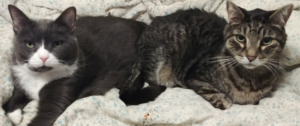 Throughout her life, Belle maintained relatively good health, though occasionally her curiosity led to concerning situations. One memorable incident involved a pain medication meant for our dog Jack. Before coming into our care, Jack had suffered a traumatic attack by two loose huskies while out walking on a leash. His injuries required veterinary treatment and a recovery period, which is how he came to stay with us. During this time, Jack was prescribed 1000 mg chewable gabapentin tablets for pain management.
Throughout her life, Belle maintained relatively good health, though occasionally her curiosity led to concerning situations. One memorable incident involved a pain medication meant for our dog Jack. Before coming into our care, Jack had suffered a traumatic attack by two loose huskies while out walking on a leash. His injuries required veterinary treatment and a recovery period, which is how he came to stay with us. During this time, Jack was prescribed 1000 mg chewable gabapentin tablets for pain management.
One day while administering Jack’s medication, the pill bottle was momentarily left open on the counter. After taking the pill to Jack in another room, we returned to find the bottle knocked over with tablets scattered across the floor. Upon gathering them up, we discovered one pill was missing.
Initially, we suspected our dog Bella had taken it, as she was found on the floor showing interest in one of the flavored chewable tablets. However, Bella couldn’t access the counter, and no other pets were visible in the area at the time.
Approximately 20 minutes later, Belle emerged from the bedroom, uncharacteristically collapsing onto the floor and falling immediately into a deep sleep. It became instantly clear that she had been the one to snatch the missing pill. We promptly contacted the pet poison control hotline (yes, they do exist), only to learn that if Belle had indeed consumed the medication, too much time had elapsed for stomach pumping to be effective. Our only option was to monitor her and wait.
After about 13-14 hours of concerning deep sleep, Belle finally awoke about 2:00 AM, acting completely normal—hungry and actively seeking food as if nothing unusual had happened. Fortunately, she suffered no lasting effects from this alarming episode.
Belle and the Lily
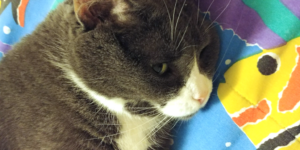 Another concerning health incident occurred when we received a flower arrangement that we placed on a table, believing it was inaccessible to our pets. Despite Belle’s decreased jumping ability as she aged, we returned from errands to discover the flower petals had been chewed. We immediately moved the arrangement to a secure area and researched the flower varieties. To our alarm, we identified lilies among the mixed bouquet. They were visible different than what we know as lilies but indeed at least one or two lilies among the arrangement.
Another concerning health incident occurred when we received a flower arrangement that we placed on a table, believing it was inaccessible to our pets. Despite Belle’s decreased jumping ability as she aged, we returned from errands to discover the flower petals had been chewed. We immediately moved the arrangement to a secure area and researched the flower varieties. To our alarm, we identified lilies among the mixed bouquet. They were visible different than what we know as lilies but indeed at least one or two lilies among the arrangement.
Lilies are extremely toxic to cats and represent one of the most dangerous household plants they can encounter. All parts of true lilies (Lilium species) and daylilies (Hemerocallis species) are poisonous to cats—including the petals, pollen, leaves, stems, and even the water in the vase. Even minimal exposure such as licking pollen from their fur after brushing against the plant or drinking water from a vase containing lilies can cause severe kidney damage.
When a cat ingests lily material, the toxic compounds are rapidly absorbed and begin attacking kidney cells within minutes to hours. This can lead to acute kidney failure within 36-72 hours if left untreated. The severity makes lily toxicity a true veterinary emergency, with treatment ideally starting within six hours of exposure for the best prognosis.
About an hour or two after discovering the damaged flowers, Belle began vomiting and developed diarrhea, confirming she was the culprit. Unlike the previous medication incident where veterinary intervention wasn’t possible, lily poisoning typically requires immediate medical attention including IV fluids, kidney function monitoring, and supportive care. However, in Belle’s case, we carefully monitored her condition and provided meticulous care at home. She was already receiving fluids and was already receiving the care should would need.
After several anxious days of close observation and attentive care, Belle gradually recovered. Her resilience was remarkable considering the potentially fatal nature of lily toxicity in cats. Following this frightening experience, we became extremely vigilant about keeping all lily varieties —including Easter lilies, tiger lilies, Asiatic lilies, and daylilies—out of our home entirely (or any flowers really), as even the smallest exposure to a lily poses a serious risk to feline health.
Belle Loses Her Brother Paws
When Paws began showing signs of illness, Belle remained constantly by his side. Both we and Belle recognized something was wrong, which only intensified our concern for Paws. The profound connection between bonded cats is truly remarkable to witness. Belle provided unwavering support and comfort throughout Paws’ illness and recovery periods. Her presence noticeably soothed him, minimizing his distress and providing emotional security.
After Paws passed away, Belle entered a profound state of depression lasting nearly two months. She immediately sensed his absence from the home. Her behavior changed dramatically—she isolated herself and found new hiding places daily. We often had to conduct thorough searches throughout the house when we became concerned about her whereabouts. Her desire for solitude was evident, and we witnessed a depth of grief in her that we had never before observed in a cat.
Even our newer cat Everly seemed to recognize Belle’s emotional state and attempted to offer comfort. After years of Belle providing emotional support to others, the roles reversed as Everly joined us and our other pets in trying to console her. During this period, Belle’s activity decreased significantly as she slept more than usual, clearly mourning Paws’ absence.
Eventually, Belle gradually emerged from her depression, slowly resuming interaction with us similar to her behavior before Paws’ passing. However, something had fundamentally changed—while she continued with life, we could tell she never fully recovered from the loss of her brother. She carried on, but a part of her seemed forever altered by his absence.
Belle and Her Health Issues Start
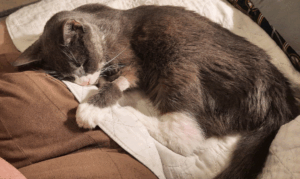 Belle eventually developed hyperthyroidism during her time with us, which we noticed when she began vomiting and losing weight. A veterinary visit and blood test confirmed our suspicions. Treatment with methimazole produced immediate positive effects—she regained weight and stopped vomiting. Her condition became highly manageable, and we observed few, if any, hyperthyroidism-related issues afterward. Her blood tests remained stable, requiring no medication increases.
Belle eventually developed hyperthyroidism during her time with us, which we noticed when she began vomiting and losing weight. A veterinary visit and blood test confirmed our suspicions. Treatment with methimazole produced immediate positive effects—she regained weight and stopped vomiting. Her condition became highly manageable, and we observed few, if any, hyperthyroidism-related issues afterward. Her blood tests remained stable, requiring no medication increases.
As Belle aged, she was also diagnosed with hypertension, similar to what Paws had experienced. The severity of her condition became apparent when she wouldn’t rise one day, appearing to be in a deep sleep but actually experiencing something more serious. A veterinary examination revealed Belle had suffered a stroke (or some kind of significant cardiac event). After trying various medications, we found an effective combination of Amlodipine, Pimobendan, and Atenolol that significantly reduced her symptoms. We came to believe she had high blood pressure like her brother Paws had.
The stroke left Belle with weakness in one hind leg, limiting her mobility and making jumping difficult. She also developed arthritis over the years, for which she received Gabapentin on particularly uncomfortable days. When her appetite decreased, we added Cerenia and Prednisolone to her regimen after noticing muscle loss. This medication combination successfully stimulated her appetite and helped maintain her muscle mass (and she put on a little weight).
 To accommodate Belle’s reduced mobility, we made several modifications around the house that allowed her to join us without needing to jump. We also adapted her litter box with a walk-in entrance rather than requiring her to climb over an edge. These changes became especially important as Belle began experiencing intermittent vision problems—her pupils would dilate widely during certain times of day, particularly affecting her daytime vision while her sight remained relatively normal in mornings and evenings. We associated these vision fluctuations with her blood pressure issues.
To accommodate Belle’s reduced mobility, we made several modifications around the house that allowed her to join us without needing to jump. We also adapted her litter box with a walk-in entrance rather than requiring her to climb over an edge. These changes became especially important as Belle began experiencing intermittent vision problems—her pupils would dilate widely during certain times of day, particularly affecting her daytime vision while her sight remained relatively normal in mornings and evenings. We associated these vision fluctuations with her blood pressure issues.
Belle’s regular veterinary visits always included comprehensive blood work, which eventually revealed elevated kidney values and slightly increased liver numbers. She was diagnosed with kidney disease and began showing associated symptoms. Our veterinary visits expanded to include monitoring all aspects of her kidney function, and we added potassium supplements to her treatment plan.
Hydration became a significant concern as her skin lost elasticity. Initially receiving occasional fluid therapy, Belle progressed to needing it daily and sometimes twice daily, though we administered fluids based on her specific needs rather than a rigid schedule.
We supplemented with HydraCare daily, which provided substantial benefits, often allowing Belle to skip fluid therapy. We monitored her hydration status daily by checking her skin elasticity and gum condition. In her final days, she typically received fluids once daily.
An ultrasound revealed a blockage in Belle’s ureter between her kidney and bladder. We ensured she had constant access to water, which she frequently utilized, and continued daily fluid therapy in hopes of flushing out the blockage. Ultrasounds consistently showed a small spot in her kidney, confirming the obstruction. Due to her advanced age, surgical intervention wasn’t an option.
During this period, Belle began urinating inappropriately in various locations, likely due to a combination of her temporary blindness and kidney issues. Veterinary examinations also revealed anemia, further indicating her advancing age and multiple health challenges.
Her blood work values, now checked weekly, continued to deteriorate, and she received ultrasounds whenever possible. As Belle grew progressively weaker, her veterinarian recommended a blood transfusion. Though expensive, it seemed a small price for a companion who had given us so much love. Following the transfusion, Belle showed immediate improvement, appearing to rally once again. However, this recovery was short-lived—within a week, she began weakening again, and her decline continued into the second week.
Belle Started Exhibiting Signs She was Going to Pass
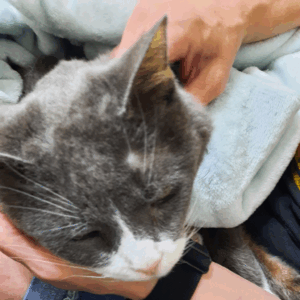 As Belle continued to weaken, it became increasingly apparent that she was approaching the end of her life. She had reached a point where she needed to be hand-fed and manually awakened for meals. Her mobility had declined significantly, making litter box visits challenging. Despite our months of intensive efforts to improve her condition, her health was clearly deteriorating beyond our ability to reverse.
As Belle continued to weaken, it became increasingly apparent that she was approaching the end of her life. She had reached a point where she needed to be hand-fed and manually awakened for meals. Her mobility had declined significantly, making litter box visits challenging. Despite our months of intensive efforts to improve her condition, her health was clearly deteriorating beyond our ability to reverse.
While wrestling with the difficult decision to help Belle pass peacefully, we noticed her interactions with us becoming increasingly limited. She rarely woke on her own, and when she did, she appeared disoriented and groggy. This dramatic change in her responsiveness forced us to evaluate her quality of life with painful honesty. Understanding we had exhausted all options for improvement, we made the heart-wrenching decision to help end her suffering. We contacted the veterinarian and arranged an appointment for that same day. The journey to the clinic, though physically short, felt emotionally endless while simultaneously seeming all too brief in retrospect.
 At the veterinary clinic, Belle received a gentle sedative followed by the final medication to ease her passing. In her final moments, we noticed her skin developing a yellow tinge—an indication that liver dysfunction had developed on top of her other health challenges. This confirmed that our painful decision was indeed the compassionate choice for Belle, despite how deeply it hurt us.
At the veterinary clinic, Belle received a gentle sedative followed by the final medication to ease her passing. In her final moments, we noticed her skin developing a yellow tinge—an indication that liver dysfunction had developed on top of her other health challenges. This confirmed that our painful decision was indeed the compassionate choice for Belle, despite how deeply it hurt us.
We arranged for Belle’s cremation, and she now rests in a special memorial area where we keep all our beloved pets who have crossed the rainbow bridge. They remain forever part of our family, present in a different form. We will profoundly miss Belle and will always cherish the joy, happiness, and love she brought to our lives and to all our other animals. Though she was with us for just over eight years, she behaved as if she had been part of our family her entire life. Our love for her will never diminish.
It’s worth emphasizing that despite Belle’s various health challenges and the numerous medications she required throughout her life—particularly toward the end—she remained comfortable and never suffered unnecessarily. Her consistently positive attitude made her passing especially difficult for us.
This experience exemplifies the responsibility of caring for a senior pet: providing constant comfort and maintaining their quality of life to the best of your ability. When these goals become impossible to achieve, you must make the decision that prioritizes their wellbeing above all else.


